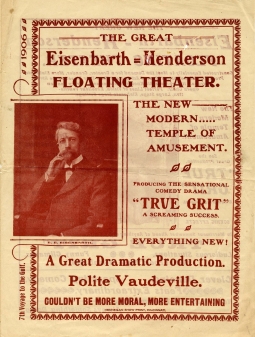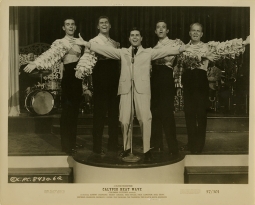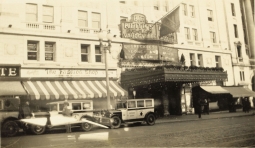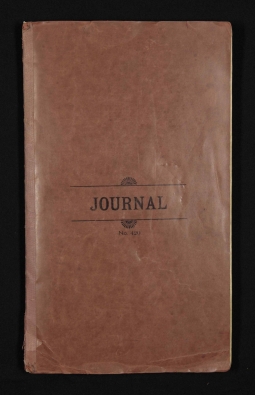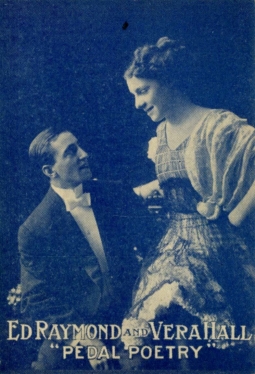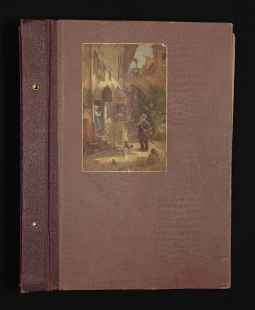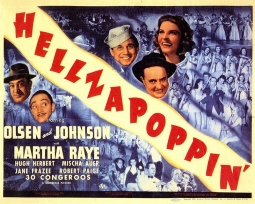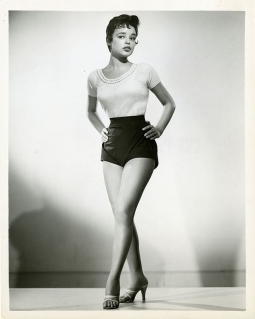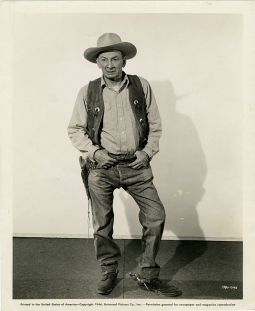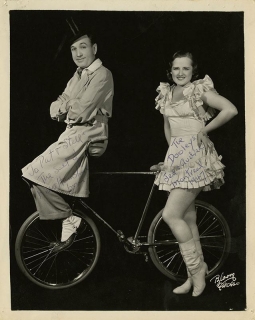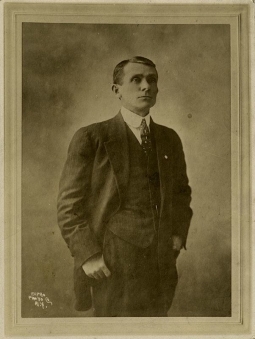Explore the Archive
Browse more than 4,321 items and 13 collections in the digital American Vaudeville Museum Archive to learn more about how this popular form of entertainment helped shape American Popular culture we know today.
Browse:
By Title
By Subject
By Types
By Date
American Vaudeville Museum Collection
The American Vaudeville Museum Collection consists of materials documenting vaudeville and other entertainment in the United States, particularly in the 1910s through 1940s. This collection is comprised of theatre programs and postcards, sheet music, magazines, playbills, photographs and posters, stage scripts and other manuscripts, clippings and scrapbooks, films, miscellaneous papers, and a large collection of LP albums, as well as some entertainers' costumes and accessories. There are also primary materials such as scrapbooks and handwritten stage scripts that document the careers of particular performers, often couples or family members. The collection focuses on vaudeville but encompasses other forms and eras of American entertainment as well, such as film and recorded music.
The collection was originally located in Boston and collected by Frank Cullen and Donald McNeilly, founders of the American Museum of Vaudeville (commonly referred to as the American Vaudeville Museum). Many of the materials pertain to the Boston and New York areas. Some items were purchased by Cullen and McNeilly; others were contributed by fans and other interested persons, or by family members of performers from the vaudeville era. Many of the histories gathered by Cullen and McNeilly were published in their periodical, The Vaudeville Times. The culmination of their research appeared in their two-volume encyclopedia, Vaudeville Old & New, co-authored also by Florence Hackman. The collection was donated to the University of Arizona by the Museum in 2008. View Items
Balasic Family Collection
The Balasic Family Collection documents the entertainment careers of Victor and Paula (Enders) Balasic, as well as their sons Alfred and Victor, Jr. Also included are Paula Enders Balasic’s family, who ran the Circus Enders in Hungary until 1905. The Balasic family toured throughout Europe and Russia as a circus and then as an acrobatic variety act known as The Great Merkels or The Five Merkels (1904-1915), The Great Enders (1915), and The 5 Balasis (1916-1924).The family came to United States in 1923 for a tour and decided to stay permanently. Victor Sr. and Paula retired around 1925. Their sons continued to perform along with Alfred's wife, Maria Holz, as the Balasi Trio (1925-1927), and finally as Florence Micareme & Co. (1927-1929), featuring Maria. As the Balasi Trio, the act featured a finger stand by Alfred and a grand finale of a head-to-head vault sequence with Victor as the vaulter, hence their byline "The Boys with the Steel Heads." View Items
Belle Story Collection
Belle Story (née Grace Leard, born 1887) was the daughter of a Midwestern Presbyterian minister who encouraged her musical training but not her stage career. She studied voice with Mme. Marcella Sembrich, and traveled to Europe around 1906 with a group to study music. She took her stage name from the maiden name of her mother, which was Storey, but she later shortened it.
By 1916 she had toured as a vaudeville singer for several years and performed at theaters including the Hippodrome in New York and the Temple in Boston and Detroit. Songs she was known for at the time included "Chin-Chin Open Your Heart", from Montgomery & Stone's "Chin-Chin, Or A Modern Aladdin" (1914); and "The Flower Garden Ball." She also performed in "Hip Hip Hooray" at the Hippodrome beginning in June 1916. She was featured in a cover article of B.F. Keith's Theatre News in May 1916. That year, at age twenty-eight, she married a Wall Street broker from Chicago, Frederic E. Andrews.
In 1917 she focused on a concert career, performing with pianist Leopold Godowsky in a program with the Russian Symphony Orchestra at Carnegie Hall, and with Enrico Caruso at the Biltmore Musicales. A promotional booklet from that time called her "America's greatest coloratura singer." Her voice was described as sweet, flute-like, and bird-like. According to her daughter, Belle was the first person to sing "Over There" in public, at a Liberty Bond rally, before it was officially published in 1917. In 1918 she performed again at the Hippodrome, as several different characters including "Columbia" in a fifteen-act musical spectacle, "Everything" by R H. Burnside.
She retired completely from performance upon remarrying four years after the death of her first husband (ca. 1930), and moved to Texas. View Items
Cato Sells Keith Collection
Cato Sells Keith (1882-1951) was born in Iowa and grew up in Helena, Montana, where his father was a newspaper editor. At eighteen he moved to Butte, MT, and worked as a reporter. By the 1910s, Cato abandoned journalism and went east pursuing a career in vaudeville. He also spent time writing stage scripts either himself or jointly. His most frequent writing collaborators, as documented in this collection, were Frank L.Whittier and Bessie Warren. During the 1920s, he toured various vaudeville circuits with Maude Parker, as "Keith and Parker." When the demand for vaudeville declined, Keith tried unsuccessfully to find work in Hollywood. Keith and Parker withdrew to a reclusive life in Montana. View Items
David Soren Popular Sheet Music Collection
When he was eight, David Soren (b. 1946) began performing in Philadelphia as a vaudevillian under the name Howard “Howie” Davis. His singing, dancing, and acting developed as he worked alongside stars such as Sally Starr, Pete Boyle (father of the actor of the same name), and Chief Halftown. He later became a regular on The Children’s Hour, a weekly live variety show. The show allowed him to do vaudeville-inspired impressions of people, such as singer Johnny Ray and dancer Gene Kelly.
By the late 1950s, the demand for vaudeville acts had disappeared, so David Soren turned to singing in local bands. Eventually, he became fascinated with the classics, leading him to pursue a career in archaeology. He received his bachelor’s degree from Dartmouth, as well as a his master’s degree and Ph.D. from Harvard. These last two degrees were in Fine Arts and Classical Archaeology, respectively.
David Soren is currently the Regents’ Professor of Anthropology and Classics at the University of Arizona, a Resident of the American Academy in Rome, and a Fellow of Great Britain's Royal Institute of International Affairs and the Johns Hopkins Schools of Advanced International Research. His work has been featured in several documentaries and scholarly publications. Besides classes about archeology, David Soren also teaches and writes about vaudeville and musicals. View Items
Dixon-Freeman Collection
The Dixon -Freeman collection documents the careers of Jessica Dixon (b.1888), a soprano singer known as "The Overseas Girl" at the end of World War I and Frank Freeman (b.1884), "The Minstrel Man." Jessica Dixon entertained American troops in England, France, and post-war Germany. Frank Freeman headed Freeman's Forty Musical Minstrels in 1918.
From 1922 to 1930 they toured together as Dixon & Freeman, and were described as "The Singer & The Minstrel" or "The Overseas Girl and That Minstrel Fellow," performing musical theater. They were known for and performed a form of blackface called "black and tan" (him black, her tan). In the mid-1920s they identified themselves as The Van Gordons. Their young daughter Kathleen (1919-2001) accompanied them on the road, and began performing with them at the age of two. Dixon subsequently taught voice in Los Angeles; Freeman served as president of California Artists' Protective Association. View Items
Frank J. Sidney Collection
Frank J. Sidney performed vaudeville in the early twentieth century. Photographs in the University of Arizona’s collection depict him performing in a variety of locations, such as a circus tour in India as The Great Sidneys, a performance troupe tour in Australia in 1908, and a troupe in Johannesburg in 1913. From 1922 to 1925, Frank J. Sidney & Co. appeared in B.F. Keith's and other theatres in Brighton Beach, Jersey City, and Philadelphia. His act at that time was called "A Morning in a Sportsman's Garden," and featured "Zillah the Singing Dog." His acts often featured acrobatic skill. View Items
Goelet Family Collection
The Goelet Family Collection documents the vaudeville careers of John William Goelet, Vera Jewel Hall, and their daughter Jane Grey Hall. John William Goelet was born December 6, 1872, in Mobile, Alabama. In his early years, John played professional baseball. He was also an accomplished musician. John petitioned and was initiated in 1918 as an Entered Apprentice Mason with the Olympia Lodge No. 864 of Ancient Free and Accepted Masons. Under the stage name of Goelet and Hall, John and his wife Vera performed their song and dance routines until John became ill in 1929. His wife and daughter, Jane, cared for him until his passing in 1939 in Chicago, Illinois. John was buried in Orrick, Missouri.
Vera Jewel Hall was born January 11, 1891, in Bonner Springs, Kansas. Vera began her career singing and dancing in Vaudeville at an early age, becoming an actress along the way. Her stage name was Baby Hall; she was also referred to as Baby Vera Hall or Little Vera Hall. At some point Vera teamed-up with Ed Raymond performing as a song and dance team, stage name, Raymond and Hall.
On October 15, 1917, Vera married John “Billy” Goelet and they became known as Goelet and Hall in the world of Vaudeville. Their daughter, Jane Grey Hall was born August 18, 1918, in Chicago, Illinois.
Vera later married Daniel C. Braun and lived in Chicago, Illinois, until his passing in 1962. Vera moved to Menlo Park, California, where she resided with her daughter Jane until her passing after a long illness, on May 18, 1971. View Items
Gondoliers-Ricci Collection
Nick Ricci was part of a Seattle musical group known originally as the Four Gondoliers and later as the Three Gondoliers, or simply the Gondoliers. The other members were Henry Ricci and Al Maletta (b.1914). Nick played violin, and the others played accordion and clarinet / saxophone. A fourth member, Henry Maiorano, also played accordion, but left the group sometime in 1934. Their nicknames were Icky, Wicky, Wacky, and Woo. They were still in high school when they began performing.
Their first documented performance is the Black Ball Line and Egyptian Theatre radio and stage contest in Seattle, Washington, in August 1933. As winners of a McKesson opportunity contest, the Four Gondoliers played in vaudeville acts with Skipper Don Mills in Portland, around Oregon, northern California, and Washington in early 1934. The act was called Don Mills and His Wonder Stars, and included a dozen other performers. By mid-1934 they were performing with Chef (Joe) Milani's cooking musicale show, in venues including Oakland and Los Angeles. By 1936 they called themselves the Three Ritto Brothers, and were touring the Bert Levey Circuit of Vaudeville Theatres. They also used the name The Three Italian Street Singers.
Information about Nick Ricci's later life is not provided. Al Maletta later moved to Yakima and started an accordion studio, according to information from the Yakima Valley Museum. View Items
Jessica Dixon and Frank Freeman Collection
The Dixon -Freeman collection documents the careers of Jessica Dixon (b.1888), a soprano singer known as "The Overseas Girl" at the end of World War I and Frank Freeman (b.1884), "The Minstrel Man." Jessica Dixon entertained American troops in England, France, and post-war Germany. Frank Freeman headed Freeman's Forty Musical Minstrels in 1918.
From 1922 to 1930 they toured together as Dixon & Freeman, and were described as "The Singer & The Minstrel" or "The Overseas Girl and That Minstrel Fellow," performing musical theater. They were known for and performed a form of blackface called "black and tan" (him black, her tan). In the mid-1920s they identified themselves as The Van Gordons. Their young daughter Kathleen (1919-2001) accompanied them on the road, and began performing with them at the age of two. Dixon subsequently taught voice in Los Angeles; Freeman served as president of California Artists' Protective Association. View Items
Jill Corey Collection
Jill Corey was born Norma Jean Speranza in Avonmore, Pennsylvania. She was the youngest of five children born to Clara and Bernard Speranza. At the age of four, she lost her mother to a serious infection. Alice, her older sister, became the dominant female presence in Jill’s life. Her father and four older brothers worked in a small, private coal mine in order to support the family. Jill started singing at the age of four. From a young age, Jill would perform at family gatherings, local talent contests, and at school. At age thirteen, she won her first competition. The contest was sponsored by a local chapter of the Lion’s Club and the prize was an opportunity to sing on a local radio station. She was an instant hit and as a result, she was given her own local weekly radio show, Dream Time.
In the spring of 1953, Jill graduated from Bell-Avon High School. That same year she was signed by Mitch Miller, the director of artists at Columbia Records in New York. Mitch Miller had Jill audition for both Arthur Godfrey and Dave Garroway. Miller contacted LIFE magazine, who decided to feature Jill Corey in the November 9, 1953, issue. She was offered television contracts and she decided to sign with Garroway. She debuted on prime time television as the lead singer for the Dave Garroway Show. With the help of the Manhattan telephone directory and Garroway’s influence, Norma Jean Speranza became Jill Corey. During this time, Jill Corey recorded her first studio single, the “Robe of Calvary” for Columbia Records. This began a long and fruitful career as a recording artist. Other major hits from Jill Corey include “I Love My Baby,” “Love Me to Pieces,” “Big Daddy,” and “Sometimes I’m Happy, Sometimes I’m Blue.”
In 1954, Jill was a regular on Stop the Music, the Robert Q. Lewis Show with Merv Griffen, and the Johnny Carson Show. In 1957, Jill became a member of the cast of the long-running staple of 50s television, Your Hit Parade. Between 1957 and 1960, Jill appeared on the Ed Sullivan Show.
In 1958, Jill became the youngest performer to ever headline at New York’s famed Copacabana. In the same year she filmed the motion picture, Senior Prom, co-starring Paul Hampton and James Komack. At this height in her career, she met Don Hoak, the third baseman for the Pittsburgh Pirates. They married in Pittsburgh in 1961, and Jill retired. In 1965, they had a daughter and named her Clare. In 1969, Don Hoak died of a heart attack, propelling Jill Corey to return to the spotlight. During her second career, she starred in many plays, both off-Broadway and on tour. Some of her plays include Annie Get Your Gun, Sweet Charity, Promises, Promises, and Gypsy at the Carousal Dinner Theater. In 1989, she played at Carnegie Hall to a sold out crowd. View Items
Leon Errol Collection
Leon Errol (1876 or 1881?-1951) was born in Australia, and began performing in college, circus, Shakespeare, and light operas. Errol migrated to the United States by 1904 with his dance partner, Stella Chatelaine (1886-1946). He performed cockney songs and eccentric dance in variety saloons and partnered with Pete Gerald as "Gerald and Errol," featuring German ("Dutch") or Irish dialect comedy, ragtime piano, burlesque boxing, and a trained bulldog named Buck. Gerald and Errol played alongside Gale Dauvrey and Alf T. Lane in "A Wife's Folly," an Edward Shields Company comedy drama, ca. 1904, in Baker City, Oregon. The trio of Gerald, Errol, and Dauvrey performed in Walla Walla, Washington, in 1904. Errol was stage manager for the Orpheum Theatre in Portland, Oregon, during the 1904-05 season, where he also performed in their productions, directing a group known as "Errol's Burlesquers," which includes future Keystone comedian Roscoe Arbuckle. Errol performed in numerous productions at LaVern's Park in Walla Walla, and at Shields' Park in Portland during this time. He and Will Gross, as "Errol and Gross," performed ragtime musicals. In 1906 Errol was traveling with Zinn's Travesty Company, which performed in San Francisco in 1906, and was there when the earthquake hit.
Leon Errol and Stella Chatelaine married in 1906. By 1911, they had arrived in New York with their burlesque comedy show, The Lilies or The Jersey Lillies. At Abe Erlanger’s (Ziegfeld’s financial backer) insistence, Leon was soon engaged by Florenz Ziegfeld in his Broadway debut, "The Winsome Widow," and then in the Ziegfeld Follies (1911-1915), in which Stella Chatelaine also performed. He co-produced and performed in two shows of "Hitchy Koo," the second in 1918. Errol was known for his dialect roles, which he originally developed to camouflage his strong Australian accent. We was also known as an eccentric dancer-physical comedian because of his comic gait as a "stage inebriate" and other eccentric roles. Errol is especially remembered for his long-running series of short comic films for RKO Radio Pictures, beginning in 1934 and continuing until his death in 1951. View Items
McWatters-Tyson Collection
Arthur McWatters (1871-1963) grew up in Saginaw, Michigan, and returned there throughout his life to hunt and fish in the area. McWatters taught piano and organ in Saginaw as a young man, and advertised himself as a "tenor balladist" with several compositions to his name. In the mid-1890s McWatters and three friends went to New York to seek careers as entertainers. Around 1900, he and Grace Tyson, who later became his wife, appeared together as McWatters & Tyson. They were a duo who sang, danced, and did comic skits, with Arthur playing guitar, banjo, and piano. In 1913-14 McWatters & Tyson toured South Africa and London, England. At that time Grace had more name recognition of the two, with her being touted as "the actress whose eyes are insured for £5000." They continued performing in an active tour schedule until the mid-1920s. Grace died in 1942 at around age sixty. Arthur retired from the stage and managed a chain of movie theaters around Freeport, Long Island, where they had been living. Arthur McWatters died at age ninety-two in 1963. View Items
Rooney Family Collection
Pat Rooney Sr. and Julia Rooney were two of the children of the original Pat Rooney (1884-1892), a boxer who became famous as a performer, especially for clog dance. Julia Rooney and her siblings began performing as children in the 1890s. Julia and her sister Josie toured as the Rooney Sisters (1903-1910), "daughters of Pat Rooney.” Their act split up when Josie married during their second European tour. In her teens, Julia became known as "The Girl with the Million Dollar Legs." Julia and the singer/actor Walter Clinton (1890-1966) performed performed together as Clinton & Rooney and married on Christmas Day 1915. In the 1920s Clinton and Rooney toured with an accompanying ten-piece band. At the end of the vaudeville era, around 1930, they relocated to Hollywood, where Julia opened a dance school. She performed in Ken Murray's Blackouts from 1942 to 1949, and appeared on television in The Sun City Scandals at the age of 82.
Pat Rooney Jr. was the son of Julia’s brother, Pat Sr., a well-known vaudeville and Broadway dancer, and his first wife, the dancer Marion Bent. Over the decades, the billing names of the male Rooneys changed; Pat Rooney referred originally to the grandfather, Pat Jr. to his son, and Pat III to the grandson. Sometime in the 1930s, after the public memory faded of the original Pat Rooney, his son, Pat II, simply dropped the “Jr.” from his billing and became Pat Rooney, while his son, Pat III, took the name Pat Rooney Jr. The Pat Rooneys (II and III) performed together in the 1930s in a father/son dance act. Pat (II)’s last notable engagement was a featured role in the cast of the original production of Guys and Dolls, where he played the role of Arvide Abernathy. Pat III largely retired from dance by 1940. He married Estelle Wright (1916-2006), whose parents, Chester A. Wright and Ola Gay Wright, were traveling wagon-show entertainers. Chet’s acts included trained dogs and birds, and marionettes. Ola sang, danced, and played mandolin and banjo. Estelle performed with her parents on the vaudeville circuit as a child. Pat and Estelle Rooney operated a hot dog stand called The Dog House in Lake Blaisdell, New Hampshire, an area that served as a summer colony for vaudeville performers, for 32 years. It closed in 1984. View Items
Sadie M. Fearen and A. Harry Chick Vaudeville Collection
Married couple Sadie M. Fearen and A. Harry Chick were vaudeville performers and managers of the Sadie M. Fearen Repertoire Company in the New England area during the early 1900s. As performers they were known for their singing, talking, and dancing comedy act. Sadie was also known as the “La Petite” Sadie M. Fearen. As managers of the Sadie M. Fearen Repertoire Company, both Fearen and Chick would often perform and manage three act comedy plays such as Little Buckshot, Among the Breakers, and Triss, or Beyond the Rockies, based on Western themes of mining and the 49ers. Some of the performers they managed for such plays include Fred Driscoll, Baby Irene Perry, and Richard H. Hogan. Touring the Boston and New England area, they would play in theatres such as Bacon Hall in Somerville, MA, as well as Natick, Woburn, and Winchester near the Boston area. View Items
